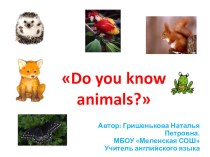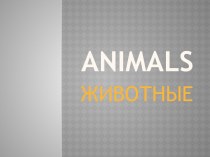- Главная
- Разное
- Бизнес и предпринимательство
- Образование
- Развлечения
- Государство
- Спорт
- Графика
- Культурология
- Еда и кулинария
- Лингвистика
- Религиоведение
- Черчение
- Физкультура
- ИЗО
- Психология
- Социология
- Английский язык
- Астрономия
- Алгебра
- Биология
- География
- Геометрия
- Детские презентации
- Информатика
- История
- Литература
- Маркетинг
- Математика
- Медицина
- Менеджмент
- Музыка
- МХК
- Немецкий язык
- ОБЖ
- Обществознание
- Окружающий мир
- Педагогика
- Русский язык
- Технология
- Физика
- Философия
- Химия
- Шаблоны, картинки для презентаций
- Экология
- Экономика
- Юриспруденция
Что такое findslide.org?
FindSlide.org - это сайт презентаций, докладов, шаблонов в формате PowerPoint.
Обратная связь
Email: Нажмите что бы посмотреть
Презентация на тему Тюмень - первый город Сибири
Содержание
- 2. Tyumen is the first Russian settlement in Siberia.
- 3. Tyumen was the first Russian town in Siberia, founded in 1586
- 4. The Tyumen coat of armsThe flag of Tyumen
- 5. Historic square Historic square is the place
- 6. Tyumen is the largest city and the
- 7. Thе bridge is over the Tura river - the footbridge or Bridge of Love.
- 8. The Tura is a river in Sverdlovsk
- 9. In the 16th century Cossack
- 10. Siberian Tatars is a native
- 11. In the summer of 1586
- 12. The Trinity Monastery, the first stone building in the town.
- 13. The Trinity Monastery
- 14. St. Michael Archangel’s Church
- 15. The industrial development
- 16. Tyumen was a transfer site for exiles
- 17. During the Great Patriotic War numerous factories
- 18. On August 14, 1944 Tyumen became the capital of Tyumen Oblast.
- 19. Tyumen region -
- 20. It was born anew of the Tyumen
- 21. Many world level oil and gas companies
- 22. Tyumen is one of the Russian towns which have its own Technopark.
- 23. Since the discovery of oil and gas Tyumen has grown fastly .
- 24. Now it covers the area of more
- 25. Many beautiful parks, squares and historical monuments
- 26. It’s The Siberian Cats’ Public Garden.
- 27. How did the Siberian cats save the
- 28. Several museums, libraries, Palaces of Culture, the
- 29. The next step of our excursion is visiting of the museums of Tyumen.Fine Arts Museum
- 30. Local Lore Museum
- 31. The Kolokolnikovs’ Estate Museum Complex
- 32. Tyumenians like to visit places of entertainment: different bars, cinemas, and night clubs.
- 33. Tyumen is a town of students. There
- 34. Tyumen is served by the Roschino Airport locates 13 km west of the city.
- 35. In 1986, in honor of
- 36. During the period from 1867 to the
- 37. Famous citizens of Tyumen Vladislav Krapivin is
- 39. Скачать презентацию
- 40. Похожие презентации
Tyumen is the first Russian settlement in Siberia.



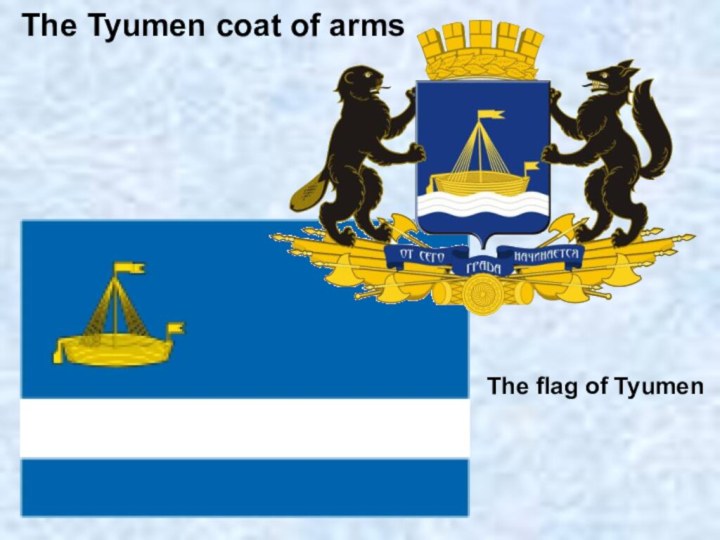
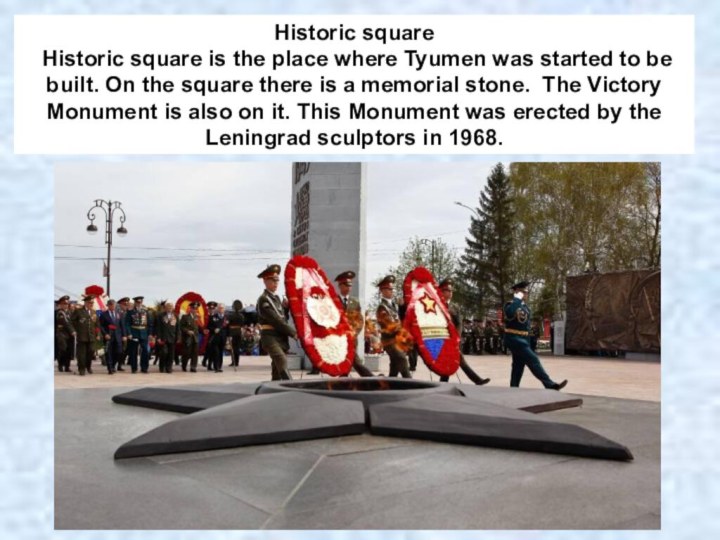
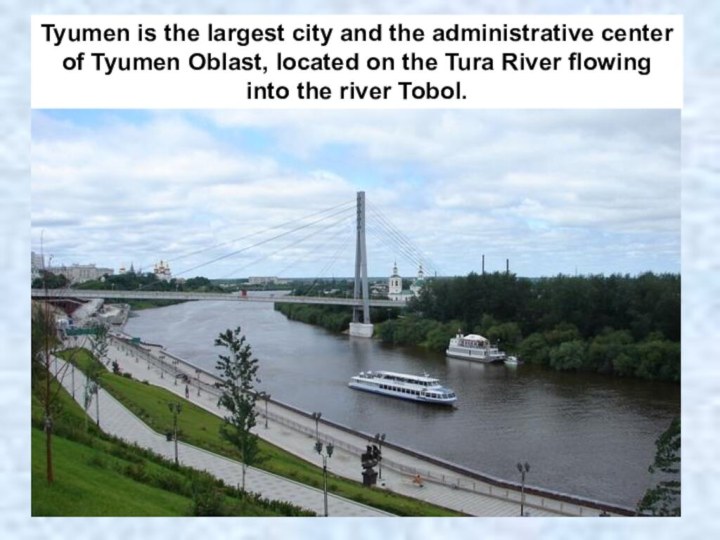










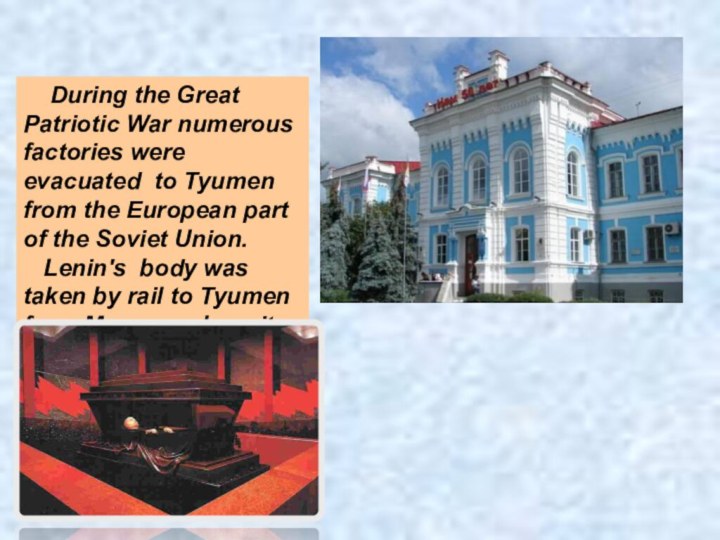




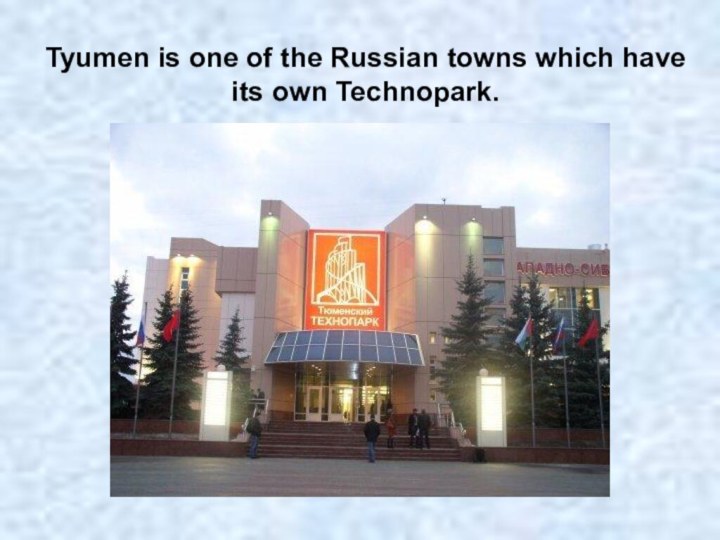











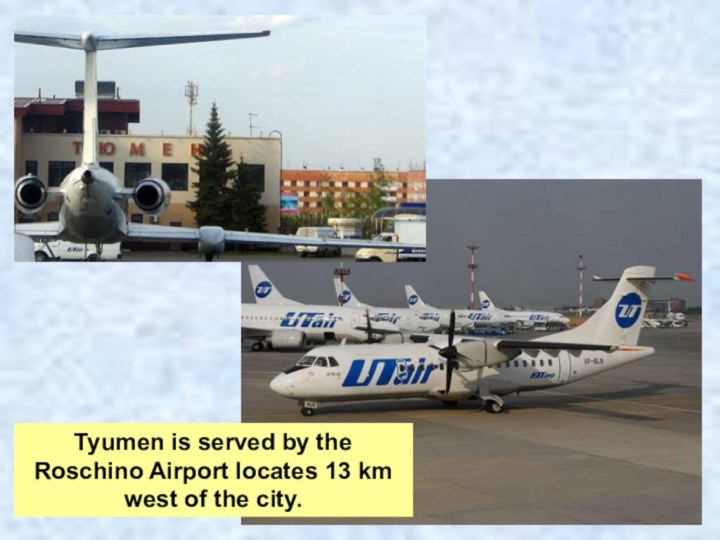

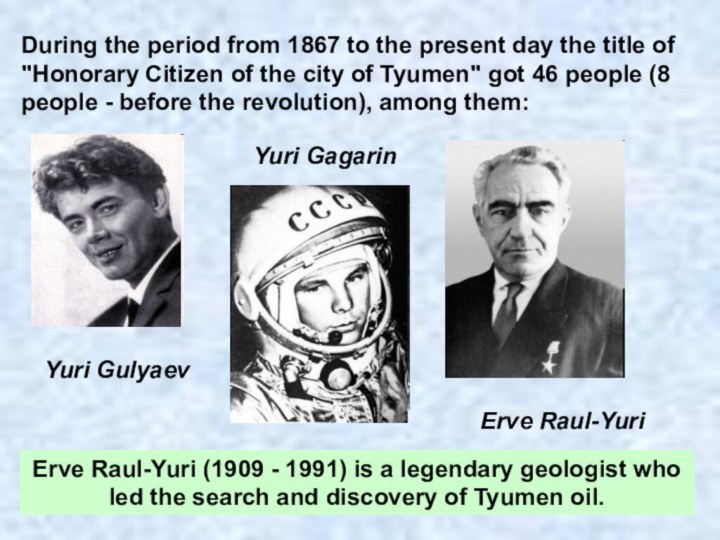



Слайд 5
Historic square
Historic square is the place
where Tyumen was started to be built. On the
square there is a memorial stone. The Victory Monument is also on it. This Monument was erected by the Leningrad sculptors in 1968.Слайд 6 Tyumen is the largest city and the administrative
center of Tyumen Oblast, located on the Tura River
flowing into the river Tobol.Слайд 8 The Tura is a river in Sverdlovsk and
Tyumen regions
of Russia. Its length is adout 1000
km. The towns of Verkhoturye, Turinsk are based on the river too . TheTura is the main source of water for Tyumen.
The Tura
The Tura
Слайд 9 In the 16th century Cossack ataman
Ermak Timofeyevich began his march to Siberia.
Ermak conquered Chimgi-Tura, the former capital of Siberian Tatars.The Tsar Ivan IV did not pay attention to Ermak's victories and only in 1586, after Ermak's death, a new tsar Feodor understood what Siberia meant for Moscow.
Слайд 10
Siberian Tatars is a
native ethnic
group of western and southern Siberia.
Siberian
Tatars called their villages as yurts . Islam came to the Siberian Tatars from Bukhara.
Слайд 11 In the summer of 1586 Moscow
voevodas Vasily Sukin and Ivan Myasnoi with military people
and cossacks marched into Siberia.On July 29, 1586 they laid foundation of Tyumen on the site of the destroyed Chimgi-Tura. Originally streltsy and
cossacks made up majority of Tyumen population.
Слайд 15 The industrial development of
Tyumen began with the construction of the Trans -
Siberian railway which connected Tyumen with the European part of Russia.Слайд 16 Tyumen was a transfer site for exiles and
prisoners. Before the October revolution Tyumen was a small
town belonging to the Tobolsk Gubemia. Originally Tyumen was built up with small primitive huts in the tradition of “peasant style”. Later on two-storey houses appeared.Слайд 17 During the Great Patriotic War numerous factories were
evacuated to Tyumen from the European part of the
Soviet Union.Lenin's body was taken by rail to Tyumen from Moscow where it was stored for the duration of the war in what is now the Tyumen Agriculture Academy.
Слайд 19 Tyumen region - one
of the largest in the Russian Federation, its area
is 8.4% of the country. As part of the Tyumen oblast are Khanty-Mansi and Yamal-Nenets Districts. the Tyumen oblast is washed by the Kara Sea. The main river of the Tyumen oblast is the Ob. Two thirds of Russian oil and gas are extracted here .Слайд 20 It was born anew of the Tyumen oblast
on June 21, 1960, the day when oil was
founded near a little village of Shaim.Слайд 21 Many world level oil and gas companies such
as Gazprom, LUKoil and Gazpromneft, Shell have their offices
in Tyumen. UTair is also based in Tyumen.Слайд 24 Now it covers the area of more than
235 square kilometers and the multinational population of Tyumen
is about 650.000 people.Слайд 25 Many beautiful parks, squares and historical monuments decorate
the image of the ancient town. The central part
of old Tyumen has many historic buildings.Слайд 27 How did the Siberian cats save the main
museum of our country?
According to the legend Tyumenians
sent 238
cats to Leningrad, gone through blockade, to save the city
from rats. 5000 pets were
sent from Siberia to Leningrad.
So Siberian cats saved one of the
main Russian museums the Hermitage.
Слайд 28 Several museums, libraries, Palaces of Culture, the Puppet
and the Drama Theatres, the Concert Hall, the Picture
Gallery make Tyumen a cultural centre.Слайд 32 Tyumenians like to visit places of entertainment: different
bars, cinemas, and night clubs.
Слайд 33 Tyumen is a town of students. There are
three universities, five academies and several tens of colleges
in Tyumen. There are about one hundred secondary schools in Tyumen.Слайд 35 In 1986, in honor of its
400th anniversary,
and for services to country the
city was awarded bythe Order of the October Revolution.
Слайд 36 During the period from 1867 to the present
day the title of "Honorary Citizen of the city
of Tyumen" got 46 people (8 people - before the revolution), among them:Yuri Gulyaev
Yuri Gagarin
Erve Raul-Yuri
Erve Raul-Yuri (1909 - 1991) is a legendary geologist who led the search and discovery of Tyumen oil.
Слайд 37
Famous citizens of Tyumen
Vladislav Krapivin is the
Russian writer, author of the books for children and
about the children.Eugene Matveev is the People's Artist of the USSR.
Grigory Syatvinda, Russian film and theater actor.
Anastasia Kuzmina, the Olympic champion







